Native Son: Pawpaws
One day I’m eating pawpaw fruits with garden guru Greg Grant over at Stephen F. Austin State University in Nacogdoches, then I close my eyes and wake up to find myself gawking at water lilies in San Angelo…with some pretty heavyweight horticulturists. Sometimes I wonder if this life of mine is all just a dream. Perhaps I’m getting ahead of myself…
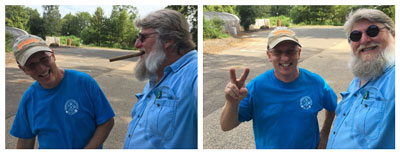
Steven (with beard) goofs around with the inimitable Greg Grant.
Pawpaw (Asimina triloba) is the only member of an otherwise-tropical plant family (Annonaceae) that extends up into temperate regions—in this case, all the way up the eastern US to Ontario, Canada! When fully ripe, the banana-textured fruit has a delicious, mango/custard-like flavor, accented by a tropical tongue-twang taste that, much like papaya, you either embrace and savor with sophisticated gusto, or get all pucker-lipped and whiny about because it doesn’t taste like something from a candy factory sealed in a cellophane wrapper. (Don’t get offended; I get all namby-pamby about mustard.)
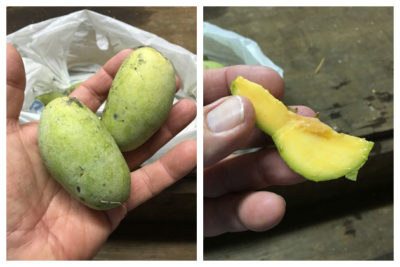
Pawpaws are the largest edible fruit native to North America.
The green-skinned, yellow-fleshed pawpaw is not a biting fruit, since it has a thickened skin and contains maybe a dozen or so large, flattened seeds. But that’s okay, because you really want to slice this thing open before you eat it. Pre-ripe, and it’s too…tart…to…tolerate. Too ripe, and it gets, shall we say, “p-p-p-pungent.” The triple Achilles heel of pawpaw, and the reason you don’t see it in grocery stores, is because it bruises easily, doesn’t ship or store well, and has a short window of perfect ripeness. (I suppose the same can be said for native persimmons.) But, there are some plant people working to breed more perfect pawpaws. If you find some at a local farmer’s market: carpe fructus!
Should you procure a perfect pawpaw, you can literally shout “God Bless America!” while eating the fruit because it indeed grows at both George Washington’s Mount Vernon and Thomas Jefferson’s Monticello, and was undoubtedly enjoyed by our founders. And, to top it off, it’s the largest edible fruit native to North America…ta-da!
Pawpaw has some interesting relatives in its family. (I’ll bet you do as well.) In frost-free areas of the world, you will likely encounter the familiar tropical fruits custard-apple, cherimoya, guanábana, and sweetsop. But my favorite pawpaw in-law is a little tree called the cananga, or ylang ylang (pronounced “ee-lang ee-lang”). Native to the islands of southeast Asia and botanically known as Cananga odorata, this evergreen rainforest tree has strange, 6 inch-long, yellow flower petals that hang down in a rather unkempt manner. But the real beauty is in the scent. Personally, I have had the pleasure to partake the fragrance of many of the world’s most famous flowers… Rosa, Gardenia, Jasminum, Dombeya, Osmanthus, Daphne, and Syringa come to mind…but cananga is perhaps the most elegant floral aroma that has ever tickled my olfactories. You would probably agree, and might not be surprised to find it is used in producing essential oils and fine perfumes, including Chanel No. 5.
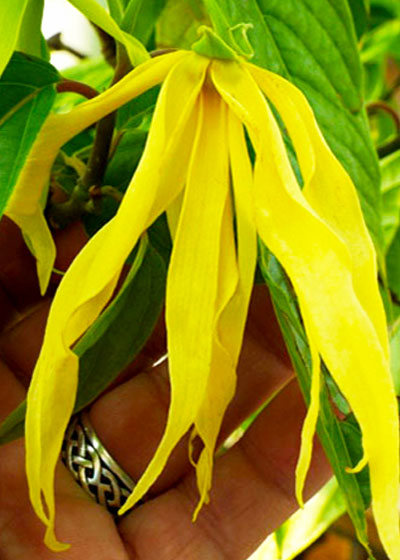
The rather humble flowers of cananga belie its refined fragrance.
I leave Greg and the pawpaws back in Nac to go to share the stage at the 5th Annual Fall Landscaping Symposium in San Angelo with TAMU legend Jerry Parsons and Rose Rustler Extraordinaire Mike Shoup. Celebrated Texan and retired AgriLife agent John Begnaud joins us and we all end up over at the International Waterlily Collection exhibit in Civic League Park. Ken Landon, pretty much the High Priest of all things waterlily, guides us through the sights. Mesmerizing, incredible, fantastic…words are simply inadequate.
Folks, the truth is that I’m already 150 words over my limit and I’ve got to wrap this thing up quick. So…Autumn is here, the pawpaws are ripe, the waterlilies are stunning, and there’s a whole wide world of cool stuff just waiting for you to discover. Go getcha some!
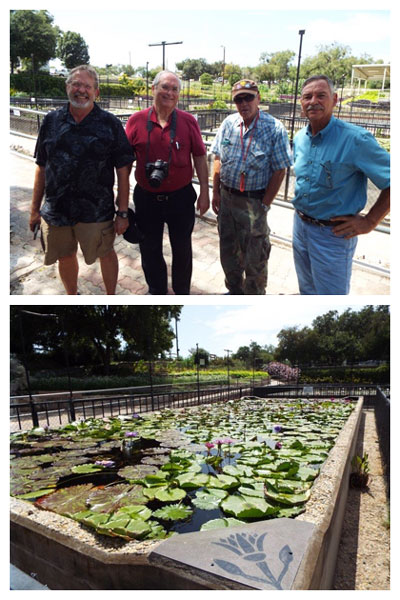
Texas Horticultural Heavyweights (from left) Mike Shoup, Jerry Parsons, Ken Landon, and John Begnaud gather to view the International Waterlily Collection exhibit in San Angelo.
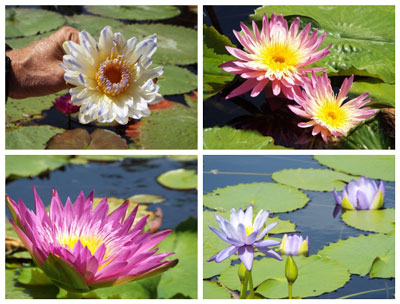
Just a few of the hundreds of insanely beautiful waterlilies in the collection. Visit www.internationalwaterlilycollection.com for details.
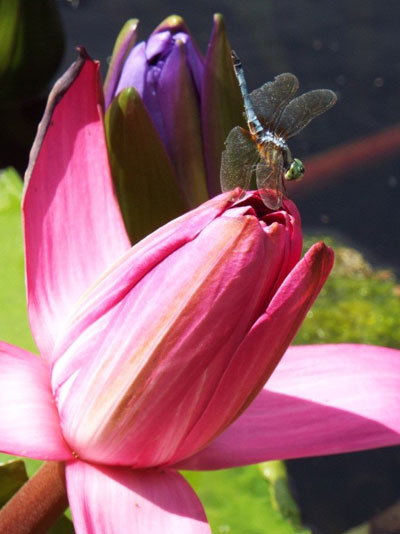
Your lagniappe: Dragonflies love the waterlily collection, too!
I need a road trip! I’d love to come out and speak to your group. I’m low maintenance, flexible, and I’ll go just about anywhere…no city too big; no town too small. Just e-mail me at stevenchamblee@yahoo.com and we’ll work something out.
Come see me at Chandor Gardens! Call 817-613-1700 or go to www.chandorgardens.com for details.
